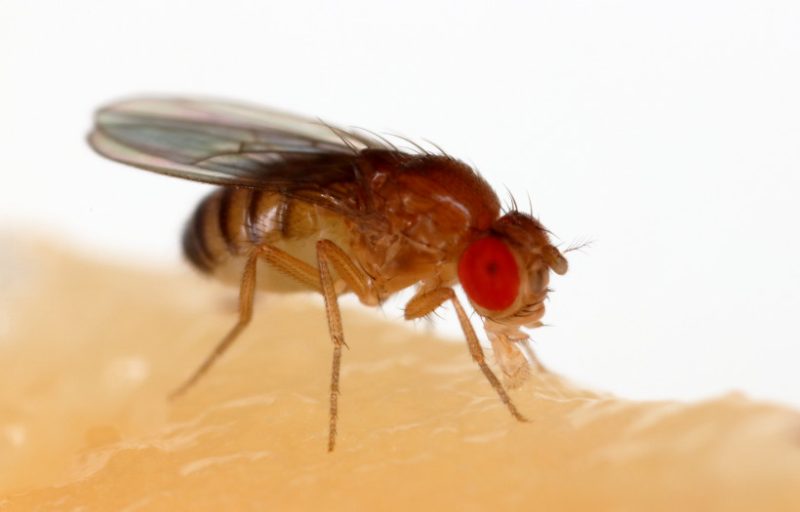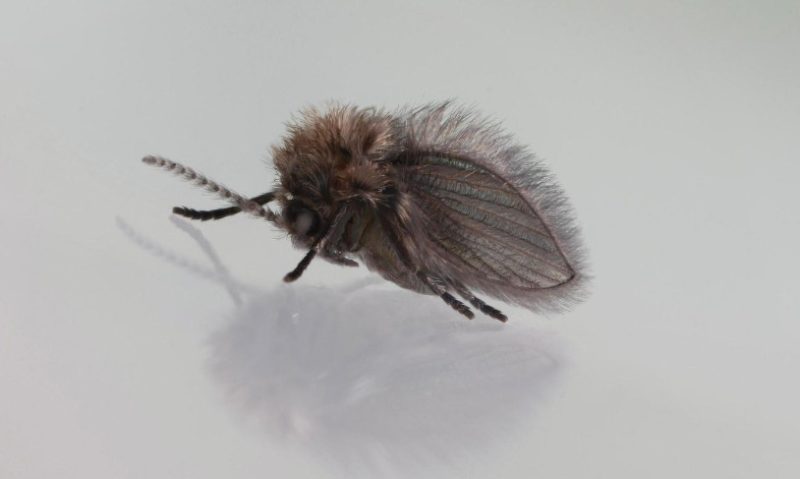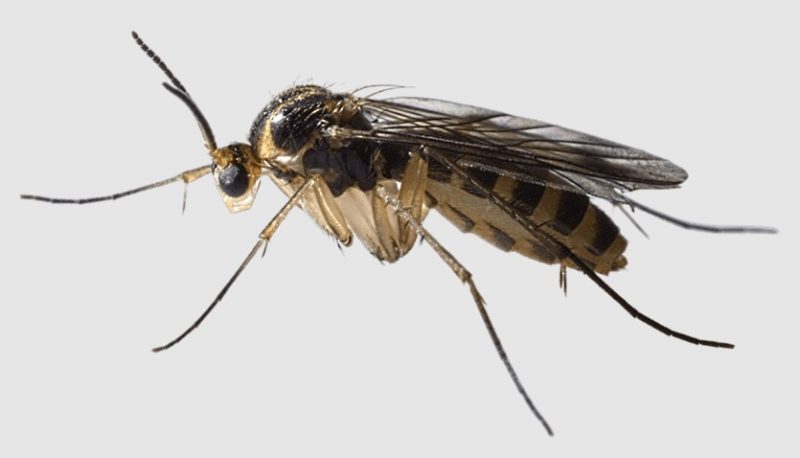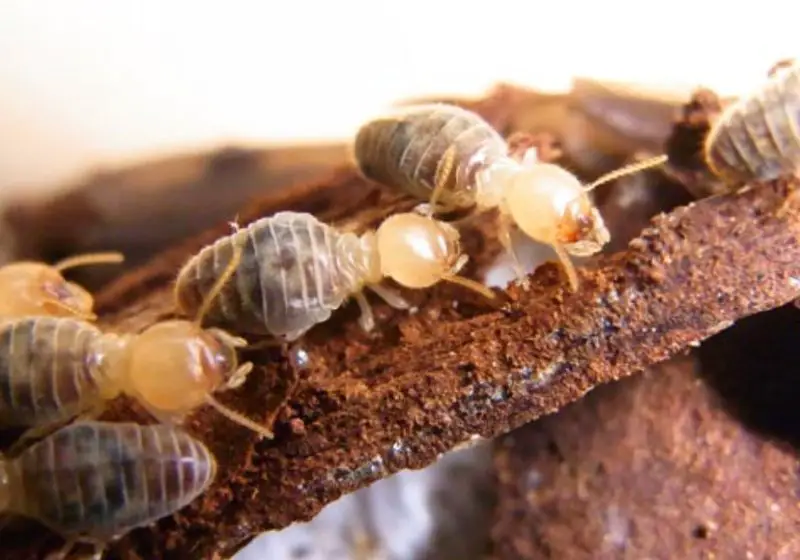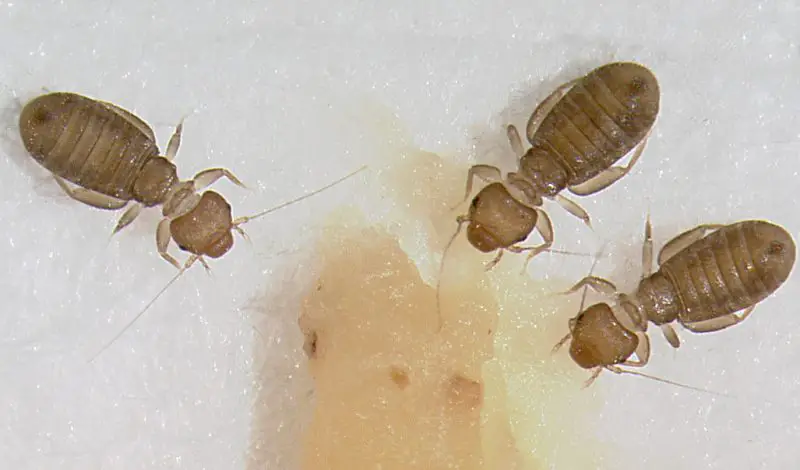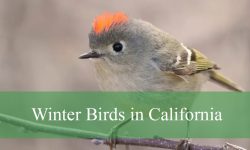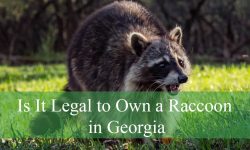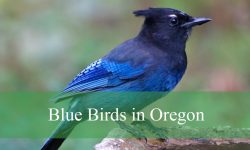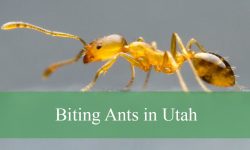Florida’s warm and humid climate makes it a paradise not only for people but also for countless species of tiny bugs. These minuscule pests can be found crawling on walls, flying around lights, or nesting in moist corners of homes. Their diversity ranges from harmless springtails to biting no-see-ums that thrive near water.
Identifying these bugs can be tricky due to their small size and similar appearances. Some are nuisance pests that invade kitchens or bathrooms, while others can cause itchy bites or damage indoor plants. Knowing what you’re dealing with is the first step toward effective pest control.
In this guide, we’ll help you recognize the most common types of tiny bugs in Florida, understand why they appear, and learn safe, effective methods to eliminate or prevent infestations.
Types of Small, Tiny Bugs Found in Florida
Ghost Ants
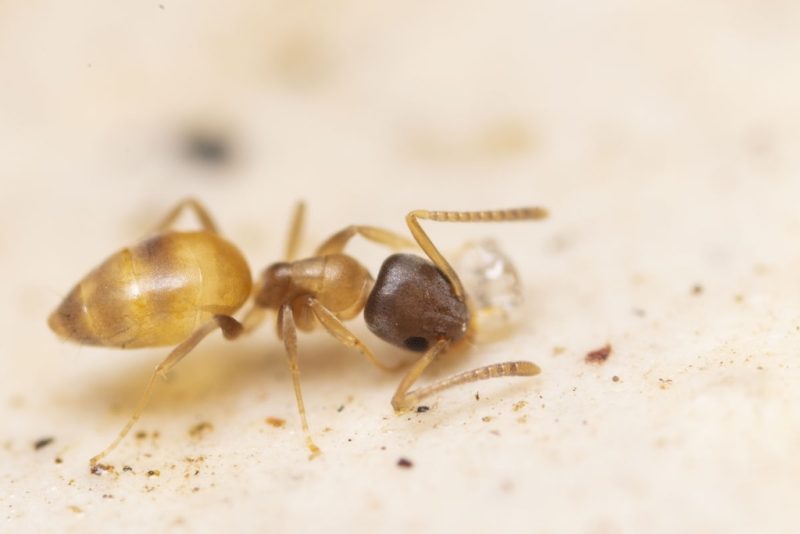
Ghost ants are tiny translucent insects measuring only about 1.3 to 1.5 millimeters long. Their pale legs and abdomen give them a ghost-like appearance, making them difficult to spot against light-colored surfaces. The head and thorax are slightly darker, often brownish, providing minimal contrast. They are known for their erratic movement and tendency to appear suddenly in kitchens and bathrooms, particularly in warm, humid areas typical of Florida’s climate.
These ants are omnivorous and are particularly attracted to sweets and greasy foods. They form large colonies with multiple queens, often nesting inside wall voids, under baseboards, and behind cabinets. Outdoors, they build nests in soil, under stones, and around plant debris. Ghost ants enter homes through the smallest cracks, following moisture trails and food sources.
While ghost ants do not bite or sting, they are considered a nuisance because of their persistent infestations and contamination of food sources. Their colonies can be challenging to eliminate due to their multiple nesting sites and fragmented colonies. In Florida, the warm environment allows them to thrive year-round, making prevention and sanitation crucial for control.
Sugar Ants
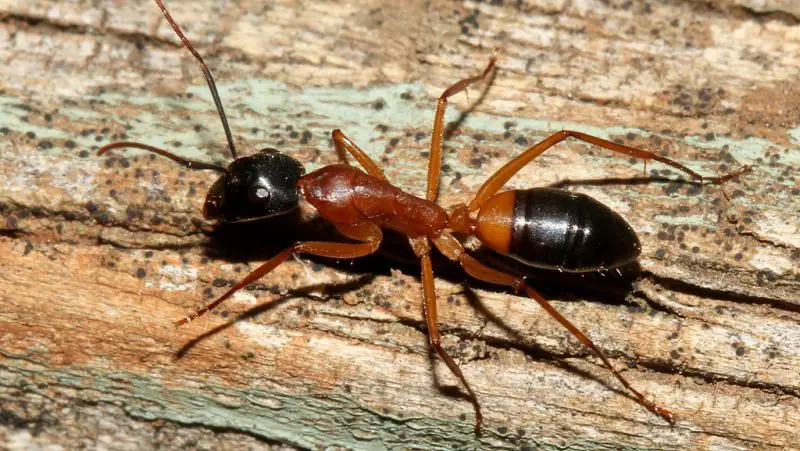
Sugar ants, a general term for various small ant species attracted to sweet substances, are particularly common across Florida. They typically measure between 2 and 4 millimeters long and can range in color from pale yellow to reddish-brown or black. Their shiny bodies and visible segmentation make them easy to recognize when they form foraging trails indoors, especially near pantries, sinks, or pet food areas.
They prefer warm, humid environments and often establish nests in soil, leaf litter, or under paving stones. Indoors, they move into walls, behind appliances, and along countertops in search of sugar, syrup, or crumbs. Colonies can contain thousands of workers, and during the rainy season in Florida, infestations increase significantly as ants seek dry shelter inside homes.
Sugar ants do not bite or sting and pose no direct physical harm to humans. However, they can contaminate food and surfaces, making them a hygiene concern. Their persistent trails can be hard to remove without locating and treating the nest. Regular cleaning, sealing entry points, and eliminating food residues are effective ways to prevent sugar ant invasions.
Pharaoh Ants
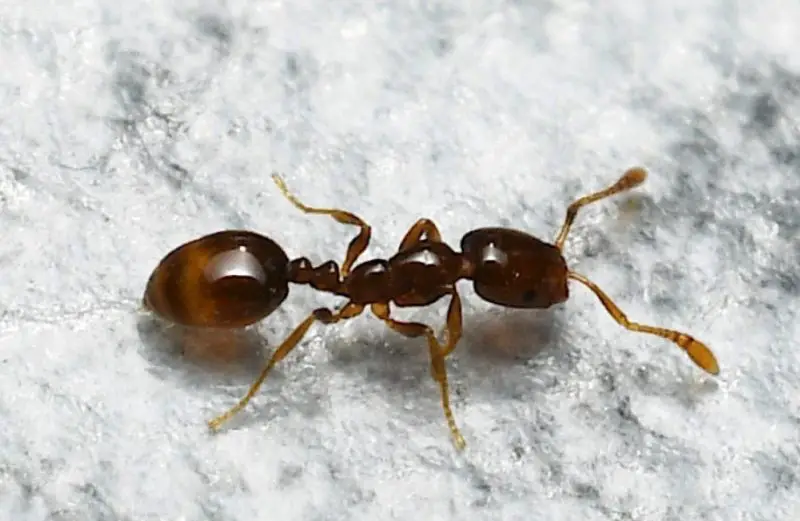
Pharaoh ants are among the smallest indoor pest ants, measuring only about 1.5 to 2 millimeters long. They are light yellow to reddish in color with darker abdomens, giving them a translucent appearance. Their small size allows them to enter through minuscule cracks and gaps, making them a common household pest across Florida. These ants are highly adaptable and thrive in warm, moist environments such as kitchens, bathrooms, hospitals, and food storage areas.
Pharaoh ants form large, multi-queen colonies that can rapidly expand through a process called “budding,” where groups of workers and queens break off to establish new colonies. They feed on sweets, proteins, and oily foods, often contaminating sterile environments. Because they nest in walls, electrical outlets, and behind baseboards, infestations can be difficult to control using traditional sprays, which may cause colonies to split and spread further.
Although pharaoh ants do not sting, they can pose health risks by contaminating food and medical supplies with pathogens like Salmonella and Staphylococcus. In Florida’s year-round warmth, they remain active continuously, requiring integrated pest management strategies for long-term control.
Fire Ants (Especially Small Workers)
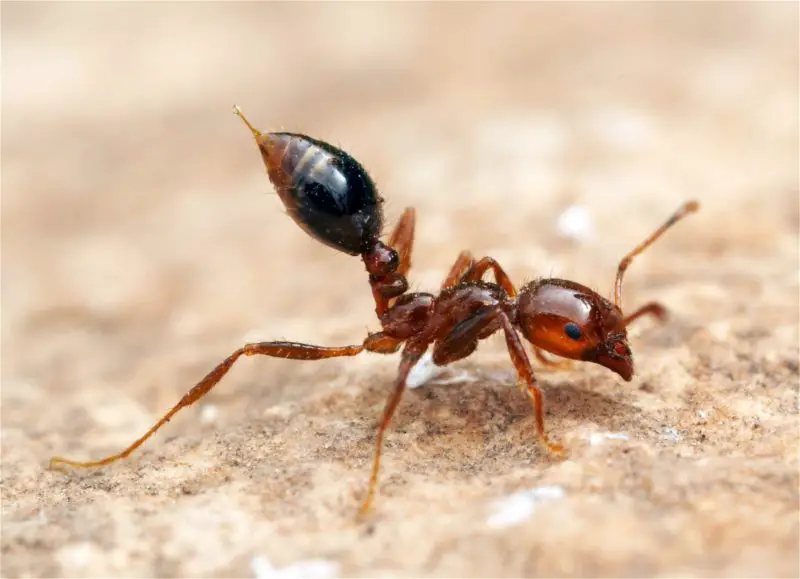
Fire ants are one of Florida’s most notorious stinging insects, recognized by their reddish-brown color and aggressive behavior. The small worker ants measure about 2 to 6 millimeters long and are often the first to emerge from disturbed mounds. Their bodies are shiny and segmented, with strong mandibles for biting and a venomous stinger at the rear. Colonies are typically found in open, sunny areas such as lawns, pastures, and roadsides.
When threatened, fire ants swarm aggressively and sting multiple times. Their stings produce a sharp burning sensation followed by itchy, pus-filled blisters. The venom contains alkaloid toxins that can cause allergic reactions in sensitive individuals, ranging from mild irritation to severe anaphylactic responses. Small workers are especially quick and numerous, making them the main attackers during a disturbance.
Fire ants build large dome-shaped mounds that can reach up to 18 inches high. They thrive in Florida’s warm, moist soil and can infest both rural and urban areas. These ants are omnivorous, feeding on insects, seeds, and even small vertebrates. Control methods often involve bait treatments and careful monitoring, as colonies can quickly relocate when threatened.
No-See-Ums (Biting Midges)
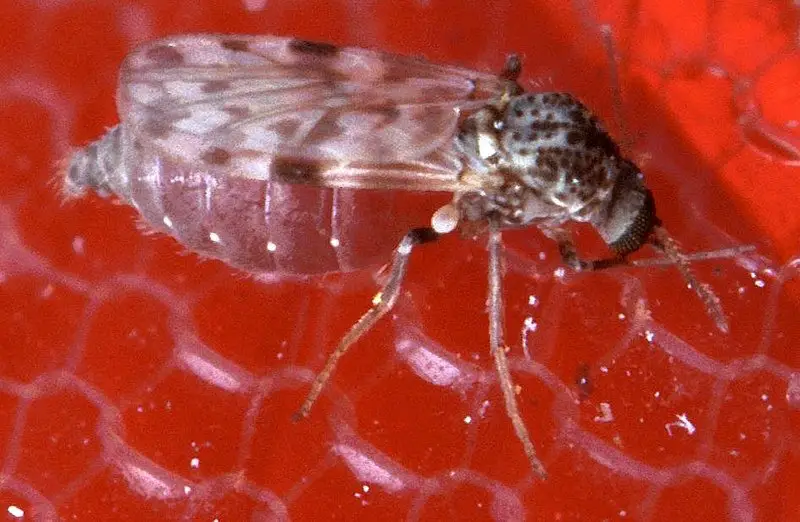
No-see-ums, also known as biting midges, are minuscule flying insects barely visible to the naked eye—typically only 1 to 3 millimeters in length. They have a grayish body, short legs, and patterned wings that appear smoky under light. Despite their tiny size, these insects are infamous across Florida’s coastal and swampy regions for their painful bites and blood-feeding behavior.
Female no-see-ums require blood meals to reproduce, often biting humans and animals during dawn and dusk. Their bites cause small red welts that can itch intensely and last for several days. Some individuals may develop allergic reactions or secondary infections from scratching. No-see-ums are drawn to moisture and carbon dioxide, making beaches, mangroves, and wetlands prime breeding grounds.
These insects lay eggs in moist soil, decaying vegetation, or tidal mud. They are most active during warm, humid months, particularly in the spring and summer. Unlike mosquitoes, no-see-ums can penetrate standard window screens, making them difficult to keep out. In Florida, residents often rely on fine-mesh screens, repellents, and fans to reduce their presence in outdoor areas.
Sand Fleas
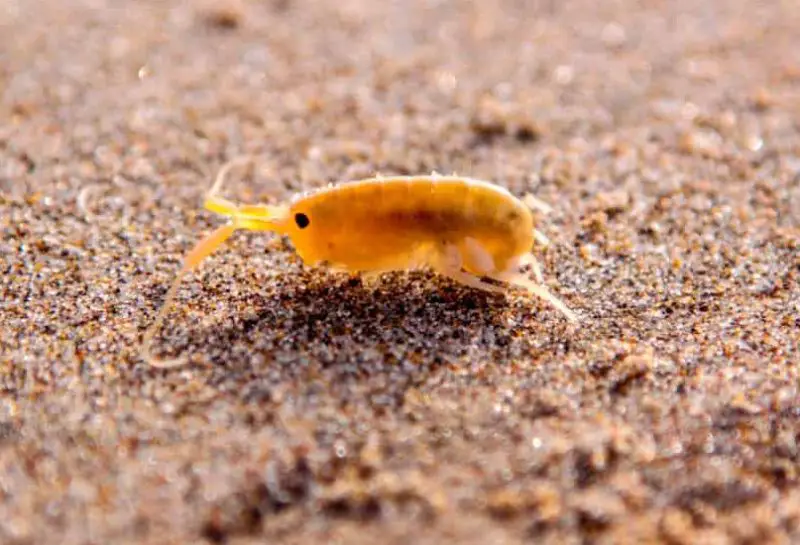
Sand fleas, also known as beach fleas or sand hoppers, are small crustacean-like creatures that resemble tiny shrimp rather than true insects. They typically measure between 0.5 to 1 inch long and have a segmented grayish or brownish body with powerful hind legs for jumping. Found along Florida’s sandy beaches, dunes, and coastal areas, these tiny creatures are often most active during the early morning and evening hours when moisture levels are higher.
While most sand fleas are harmless scavengers feeding on organic debris, some species can bite humans. Their bites can cause red, itchy welts that resemble mosquito bites and may swell or become infected if scratched. In rare cases, tropical species can burrow into the skin, but this behavior is uncommon in Florida’s native sand fleas. The discomfort caused by bites typically fades within a few days.
Sand fleas thrive in moist, sandy environments and are drawn to decaying seaweed or beach vegetation. They often emerge after storms or high tides. Because they are attracted to body heat and movement, people walking barefoot on wet sand are the most likely to be bitten. Avoiding beach activity at dusk and using insect repellents can help prevent bites.
Thrips
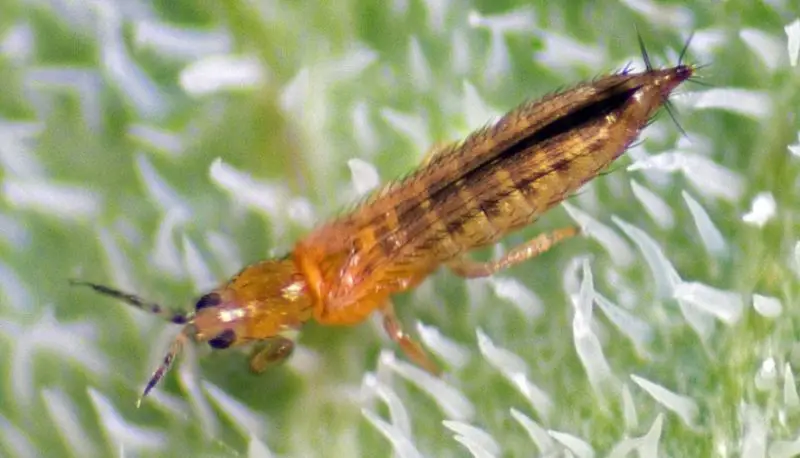
Thrips are tiny, slender insects measuring only 1 to 2 millimeters long, with narrow wings fringed by fine hairs. Their colors vary from pale yellow to dark brown, depending on the species. Common in Florida’s tropical and subtropical climate, they infest ornamental plants, fruit trees, and vegetables, feeding by piercing plant cells and sucking out the contents. This causes leaves to appear silvery, stippled, or deformed.
Thrips are highly active during warm months and thrive in both indoor and outdoor environments. Indoors, they may appear near windows or houseplants, while outdoors, they cluster on flowers and foliage. Their small size allows them to go unnoticed until significant plant damage occurs. They reproduce rapidly, and females can lay dozens of eggs within plant tissues, making infestations difficult to control once established.
Although thrips can bite humans, their bites are harmless and cause only mild irritation or tiny red marks. They are not venomous or disease-transmitting but can be a nuisance in large numbers. In Florida’s humid environment, their populations flourish year-round, requiring consistent monitoring and biological or chemical control for gardeners and farmers.
Springtails
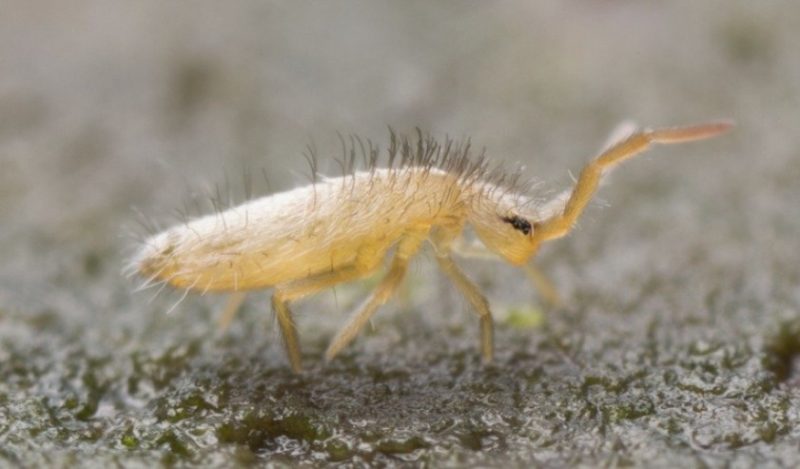
Springtails are minuscule, wingless insects typically less than 2 millimeters long. They are named for their forked tail-like appendage called a “furcula,” which allows them to jump several inches when disturbed. Their colors range from white and gray to dark brown or even blue, depending on the species. In Florida, they thrive in damp areas like bathrooms, basements, mulch, and soil, where they feed on fungi, decaying vegetation, and mold.
These creatures are harmless to humans and pets—they neither bite nor sting. However, their presence in large numbers can be alarming, especially after heavy rains or when indoor humidity levels rise. Because they rely on moisture, they often appear near leaky plumbing, potted plants, and air-conditioning systems. When conditions dry out, springtails die off or move elsewhere.
Springtails play a beneficial role in ecosystems by decomposing organic matter and enriching soil. In Florida’s warm and humid climate, they reproduce quickly, sometimes creating temporary infestations. Reducing moisture, improving ventilation, and sealing entry points are effective ways to keep springtails under control indoors.
Booklice
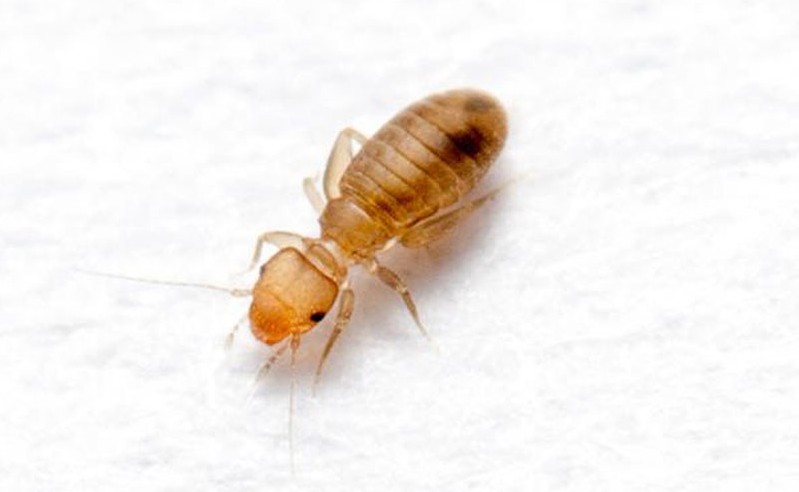
Booklice are tiny soft-bodied insects measuring about 1 to 2 millimeters long. They are pale white, gray, or light brown and resemble miniature termites. Unlike true lice, they do not bite or feed on blood. Instead, they consume mold, fungi, and microscopic organic debris. In Florida, booklice are common in humid homes, particularly around stored papers, old books, wallpaper, and pantries where moisture accumulates.
These insects thrive in environments with high humidity and poor ventilation. You can often find them inside wall voids, cardboard boxes, or near air-conditioning vents. They multiply quickly when mold spores are present, and infestations are usually a sign of excessive moisture. While they are harmless to humans, booklice can damage paper, old documents, and stored grains, making them a nuisance in libraries, storage rooms, and pantries.
In Florida’s humid climate, booklice can be active year-round. Controlling them involves reducing humidity levels below 50%, improving airflow, and removing mold sources. Dehumidifiers and desiccants can help prevent their return. Since they do not sting, bite, or transmit disease, they are more of a household annoyance than a health threat.
Dust Mites
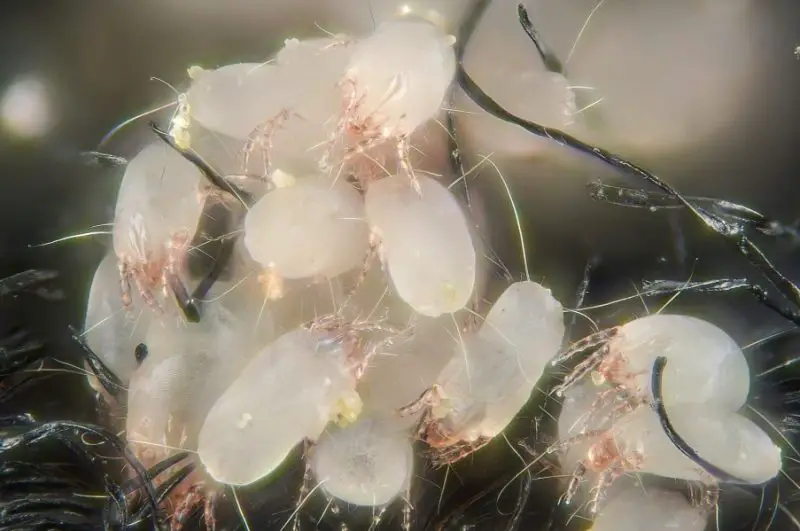
Dust mites are microscopic arachnids measuring about 0.2 to 0.3 millimeters in length—too small to be seen without magnification. They have translucent, rounded bodies and eight legs, resembling miniature ticks. Dust mites thrive in Florida’s warm and humid climate, where they feed on flakes of human skin, pet dander, and organic debris found in bedding, carpets, and upholstered furniture.
Although dust mites do not bite or sting, they are one of the most common indoor allergens. Their waste particles and body fragments can trigger allergic reactions, asthma, and respiratory irritation in sensitive individuals. Symptoms often include sneezing, itchy eyes, and congestion. Homes with high humidity, poor ventilation, or heavy carpeting are particularly prone to infestations.
Controlling dust mites in Florida requires consistent humidity management, ideally keeping indoor levels below 50%. Regular washing of bedding in hot water, vacuuming with HEPA filters, and using allergen-proof mattress covers can significantly reduce their presence. While invisible to the naked eye, these tiny creatures are among the most pervasive and problematic indoor pests in humid environments.
Carpet Beetle Larvae
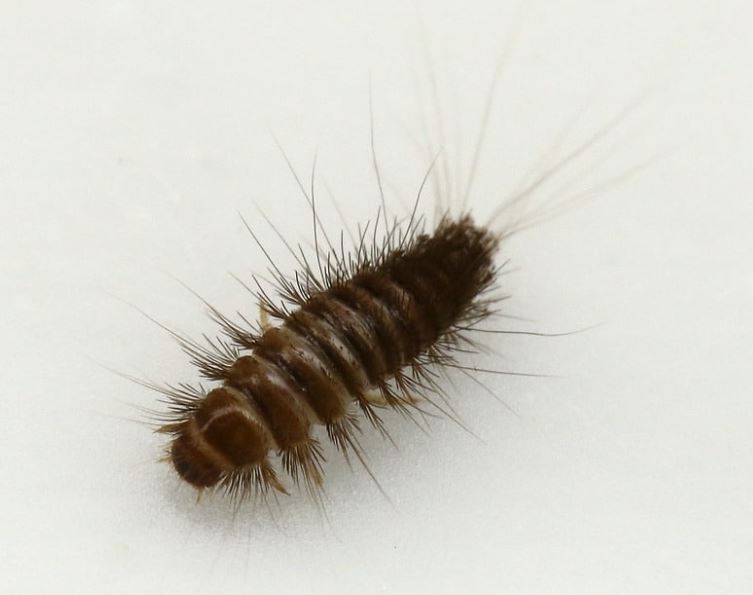
Carpet beetle larvae are small, worm-like pests that range from 2 to 5 millimeters long and are covered in short, bristly hairs. Their coloration varies from brown to dark orange, and they often have alternating light and dark stripes along the body. These larvae are the damaging stage of the carpet beetle’s life cycle and are notorious for feeding on natural fibers such as wool, silk, leather, and even pet hair. In Florida, they are found indoors year-round due to the consistently warm climate.
The larvae prefer dark, undisturbed areas such as closets, under furniture, behind baseboards, and inside stored clothing or fabric. They feed silently, leaving behind irregular holes and shed skins as evidence of their presence. Because they are photophobic (light-avoiding), infestations often go unnoticed until damage has already occurred. Carpet beetle larvae can also feed on stored products like grains and dried pet food.
These larvae do not bite or sting, but the tiny hairs on their bodies can cause skin irritation or allergic reactions in some individuals. Managing infestations involves regular vacuuming, laundering infested materials, and sealing potential entry points. In Florida’s humid conditions, preventing mold and dust accumulation also helps reduce their food sources.
Fleas
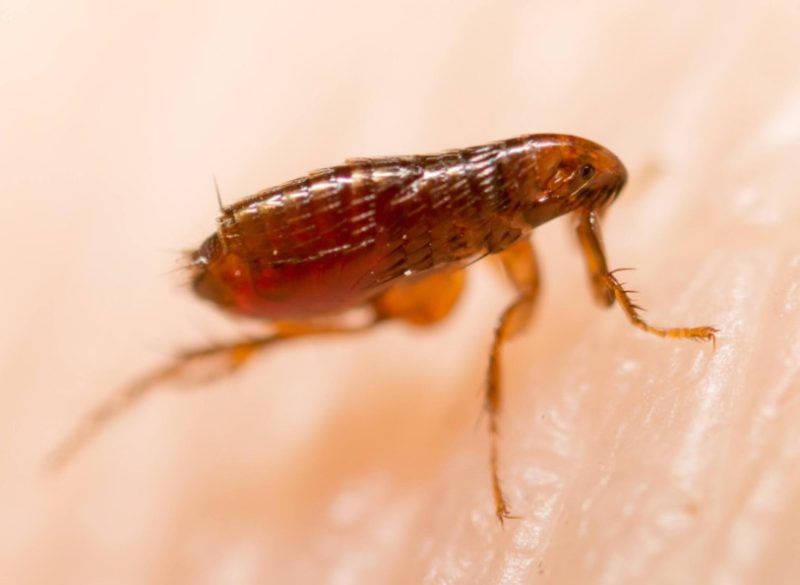
Fleas are tiny, wingless, blood-feeding insects measuring about 1 to 3 millimeters long, with flattened reddish-brown bodies and strong hind legs designed for jumping. In Florida, where warm, humid weather prevails almost year-round, fleas are a common nuisance for both pets and humans. Adult fleas feed on blood, while larvae live in carpets, bedding, and soil, feeding on organic debris and dried blood.
They are most often associated with dogs, cats, and wildlife such as raccoons and opossums. Flea bites cause small, itchy red bumps, often concentrated around the ankles or waistline. In severe infestations, they can transmit tapeworms and bacterial infections. Because Florida’s climate allows for continuous flea breeding, infestations can occur indoors and outdoors throughout the year.
Controlling fleas requires a multi-step approach: treating pets with veterinarian-approved flea control products, cleaning living areas thoroughly, and using insect growth regulators to disrupt their life cycle. Outdoor management is also important since fleas can thrive in shaded, moist soil where pets rest. Preventive care and regular vacuuming are key to keeping fleas under control in Florida homes.
Bed Bugs
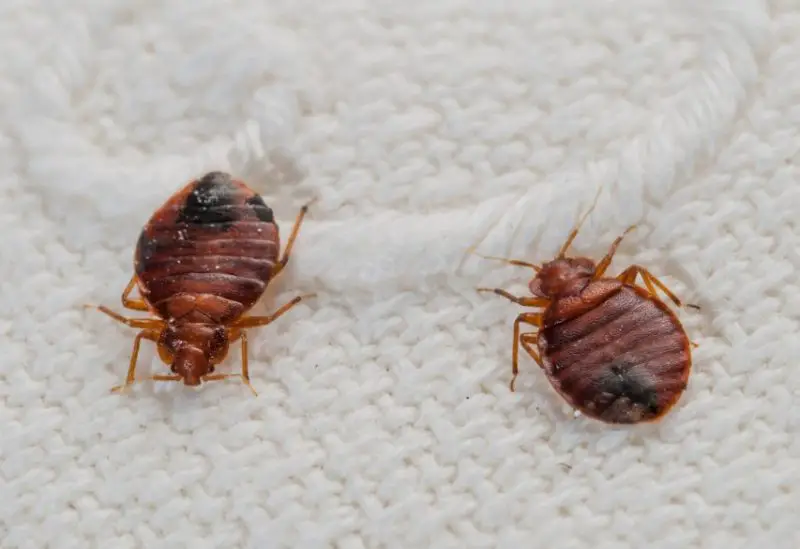
Bed bugs are small, oval-shaped insects measuring about 4 to 6 millimeters long. They are reddish-brown, flat, and wingless, becoming more swollen and darker in color after feeding on blood. In Florida, bed bugs are common in hotels, apartments, and homes, thriving in the warm, stable indoor environments that favor year-round activity. They hide in cracks, seams of mattresses, headboards, and furniture during the day and emerge at night to feed on sleeping humans.
Bed bug bites appear as small, itchy welts often arranged in lines or clusters. Although they do not transmit diseases, their bites can cause allergic reactions and insomnia due to discomfort and anxiety. Infestations often spread through luggage, used furniture, or clothing, making Florida’s tourist-heavy areas especially susceptible to outbreaks.
Because bed bugs are excellent hiders and resistant to many insecticides, eradication can be challenging. Heat treatments, professional pest control, and thorough cleaning of infested areas are often necessary. Regular inspections, especially after travel, are crucial for prevention. Their persistence and rapid reproduction make them one of Florida’s most difficult pests to eliminate.
Whiteflies
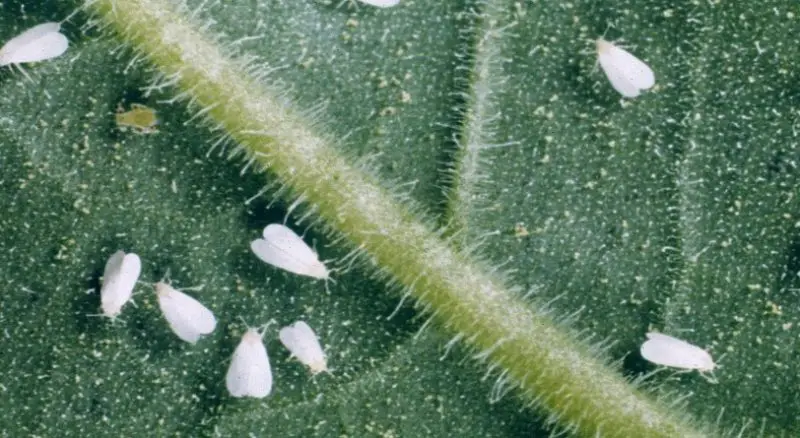
Whiteflies are small, sap-sucking insects that resemble tiny white moths. They typically measure about 1 to 2 millimeters long and have four powdery white wings and yellowish bodies. In Florida’s tropical and subtropical environment, whiteflies are a common garden pest, infesting ornamental plants, vegetables, and fruit trees. They congregate on the undersides of leaves, feeding on plant sap and excreting sticky honeydew that encourages mold growth.
Infestations cause yellowing, leaf curling, and stunted plant growth. Over time, plants may weaken or die due to nutrient loss. Whiteflies reproduce rapidly, with multiple generations occurring each year in Florida’s warm climate. They are particularly problematic in greenhouses and home gardens, where they can spread plant viruses.
Whiteflies do not bite humans or animals, but their impact on vegetation is severe. Controlling them involves removing heavily infested leaves, introducing natural predators like ladybugs, and using horticultural oils or insecticidal soaps. In Florida, maintaining proper plant health and avoiding over-fertilization can help reduce infestations and limit their spread.
Spider Mites
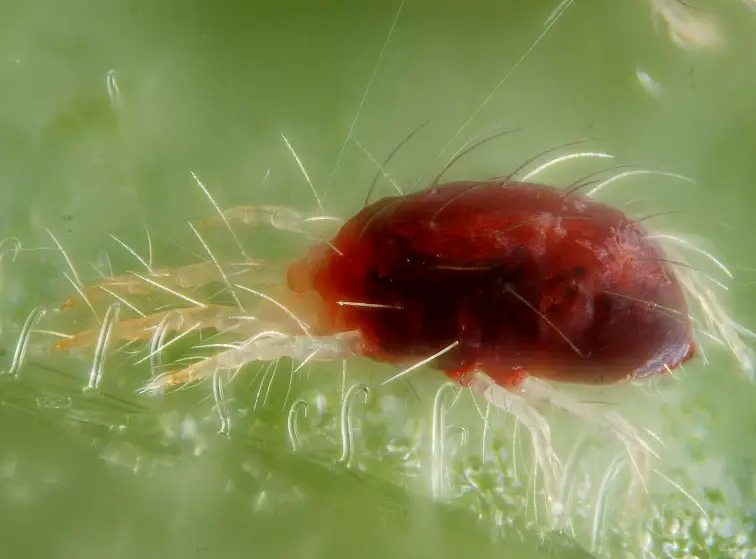
Spider mites are tiny arachnids, not insects, typically measuring less than 0.5 millimeters in length. They are often red, yellow, or green and can be recognized by the fine silk webbing they produce on the undersides of leaves. Common species in Florida include the two-spotted spider mite, which thrives in hot, dry conditions but can also flourish in humid environments when plant hosts are abundant.
These pests feed on plant cells by piercing the leaf surface and sucking out fluids, causing stippling, discoloration, and eventual leaf drop. Infested plants may look dusty or speckled, and in severe cases, webs may cover entire leaves or stems. Spider mites reproduce quickly, completing a life cycle in as little as a week during Florida’s warm months.
Spider mites do not bite humans or pets, but their infestations can devastate ornamental plants, vegetables, and fruit trees. Regularly misting plants, maintaining humidity, and using miticides or natural predators like predatory mites can help control their population. In Florida’s favorable climate, constant vigilance is essential, as infestations can spread rapidly within gardens and greenhouses.
Bark Lice
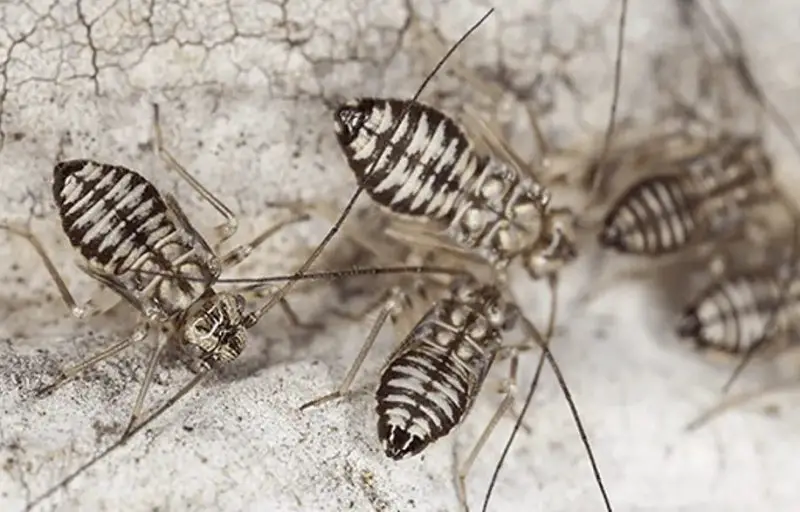
Bark lice, sometimes called tree cattle, are small, soft-bodied insects typically measuring 1 to 5 millimeters long. They are often pale gray, brown, or translucent, and some species have delicate, transparent wings held roof-like over their bodies. Common in Florida’s humid climate, bark lice live on the surfaces of tree trunks, branches, fences, and even house siding, where they feed on mold, algae, lichen, and organic debris.
These insects are communal and often appear in clusters, moving in synchronized groups that resemble a slow-moving swarm. They spin fine silk webbing over bark surfaces, which protects them from predators and harsh weather. While their webs may look alarming, bark lice do not damage trees or structures. In fact, they are considered beneficial because they help clean bark surfaces by consuming organic buildup.
Bark lice do not bite, sting, or pose any risk to humans or pets. Their presence is most noticeable during warm, moist months in Florida when they reproduce rapidly. The webbing they create eventually weathers away naturally. No control is necessary, as they are harmless and typically disappear when environmental conditions change.
Aphids
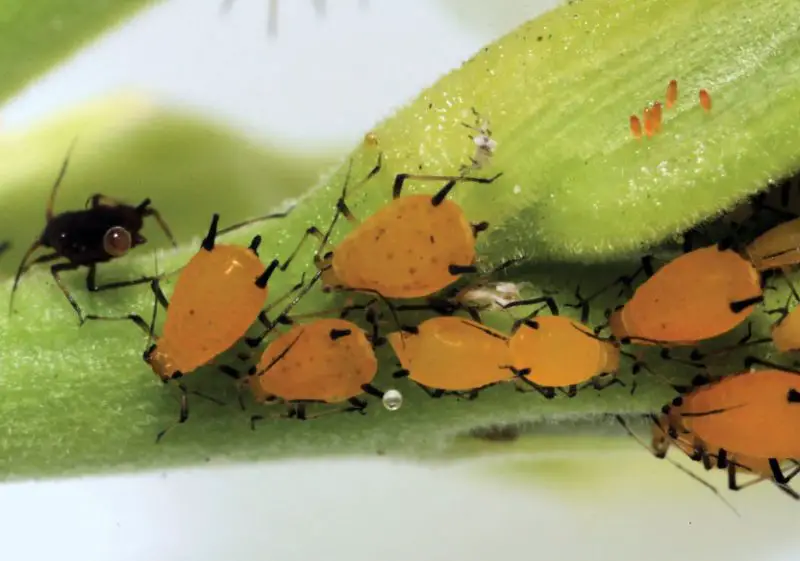
Aphids are tiny, soft-bodied insects measuring about 1 to 3 millimeters long, with pear-shaped bodies and long antennae. They come in various colors—green, black, yellow, pink, or brown—and are among the most common garden pests in Florida. These insects feed by piercing plant tissues and sucking sap, which weakens plants and causes leaf curling, distortion, and stunted growth.
Aphids reproduce quickly, with females capable of producing live young without mating. Colonies often cluster on new shoots, leaf undersides, and flower buds, where they excrete sticky honeydew. This sugary residue attracts ants and encourages the growth of black sooty mold. Because Florida’s mild winters allow aphids to remain active year-round, infestations can escalate rapidly.
Though aphids do not bite humans or animals, they can transmit plant viruses and significantly reduce crop yields. Controlling them involves washing plants with water, introducing natural predators such as ladybugs, or using horticultural oils. Regular plant inspection and avoiding over-fertilization can help prevent large infestations in Florida gardens.
Mealybugs
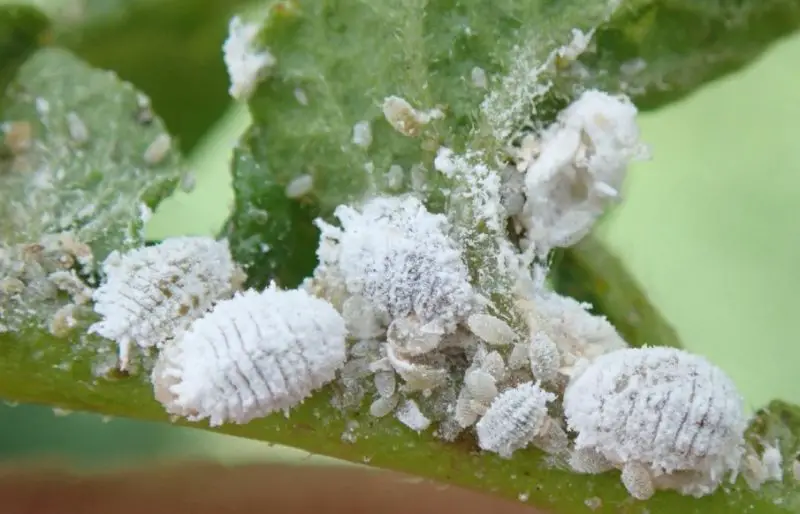
Mealybugs are small, oval-shaped insects measuring about 2 to 4 millimeters long and covered in a white, cottony wax. They are soft-bodied and slow-moving, often clustering in protected plant areas such as leaf joints, undersides, and stems. In Florida, where warmth and humidity promote their survival, mealybugs are a frequent pest on houseplants, ornamentals, and fruit trees.
These insects feed on plant sap, weakening the host and causing yellowing, leaf drop, and stunted growth. As they feed, they excrete honeydew that encourages mold growth and attracts ants. Mealybugs reproduce quickly, and infestations can spread from one plant to another if left untreated. Because they are protected by their waxy coating, they can resist some insecticides, making control more difficult.
Mealybugs do not bite or sting humans, but they can cause serious damage to indoor and outdoor plants. Effective control includes wiping them off with alcohol-dipped cotton swabs, pruning infested areas, or applying insecticidal soap. In Florida’s tropical climate, monitoring plants regularly and maintaining proper air circulation are essential to keeping them in check.
Scale Insects (Tiny and Immobile)
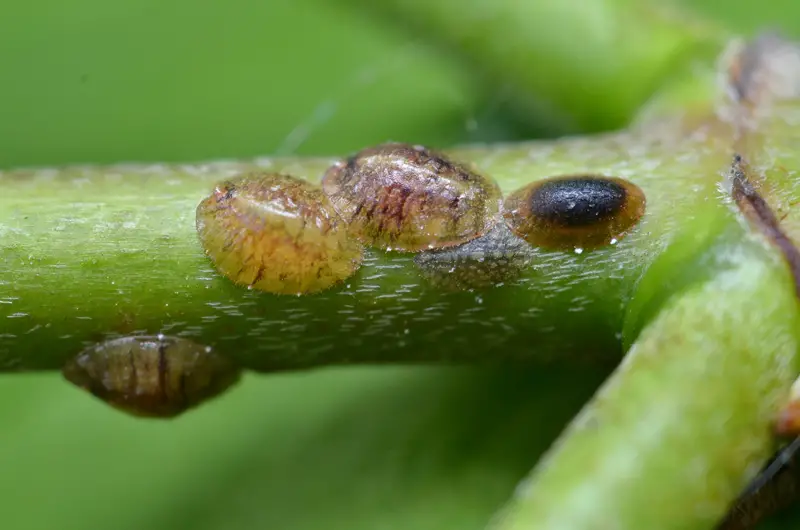
Scale insects are small, sap-sucking pests that appear as tiny, immobile bumps on plant stems and leaves. They range from 1 to 6 millimeters in size and can be brown, white, or translucent depending on the species. These insects cover themselves with a hard or waxy protective shell that makes them look like small blisters or scabs on plant surfaces. In Florida, scale infestations are common in ornamental plants, citrus trees, and houseplants.
Unlike most insects, adult female scales are immobile and remain fixed in place while feeding on plant sap. Over time, heavy infestations cause yellowing, leaf drop, branch dieback, and reduced plant vigor. They also secrete honeydew, which attracts ants and promotes mold growth. Because they hide under their protective covers, scales are often overlooked until significant damage occurs.
Scale insects do not bite or sting humans, but they can devastate plants if untreated. In Florida’s warm climate, they reproduce multiple times per year. Control methods include pruning infested branches, using horticultural oil sprays, and introducing natural predators like lady beetles. Consistent inspection and early intervention are vital to preventing widespread infestations.
Clover Mites
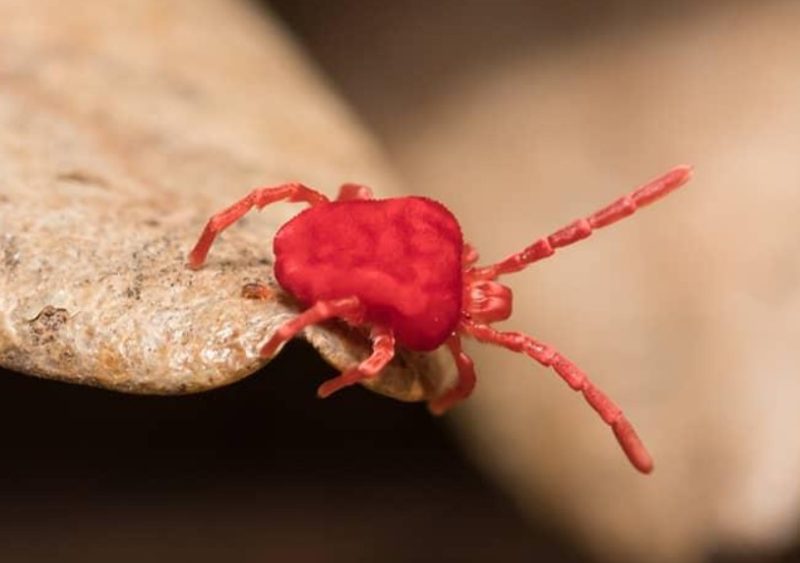
Clover mites are tiny arachnids, only about 0.5 millimeters long, making them barely visible to the naked eye. They are reddish or dark brown and oval-shaped, with long front legs that extend forward like antennae. These mites are common in Florida, particularly during spring and fall when temperatures are mild. They often invade homes from lawns and gardens, crawling on walls, windowsills, and indoor surfaces in large numbers.
Unlike many mites, clover mites do not bite or sting humans or pets. They feed on plant sap from grasses, clover, and ornamental plants. Indoors, they are mostly a nuisance because when crushed, they leave red stains on walls and fabrics. Florida’s warm, humid environment supports year-round plant growth, providing ideal conditions for clover mite populations to thrive outdoors.
To prevent infestations, maintain a vegetation-free zone around building foundations, seal cracks, and reduce excess lawn fertilization that attracts them. Vacuuming and gently wiping surfaces help remove mites indoors. While harmless, their sheer numbers can be frustrating for homeowners in Florida’s lush, green landscapes.
Mold Mites
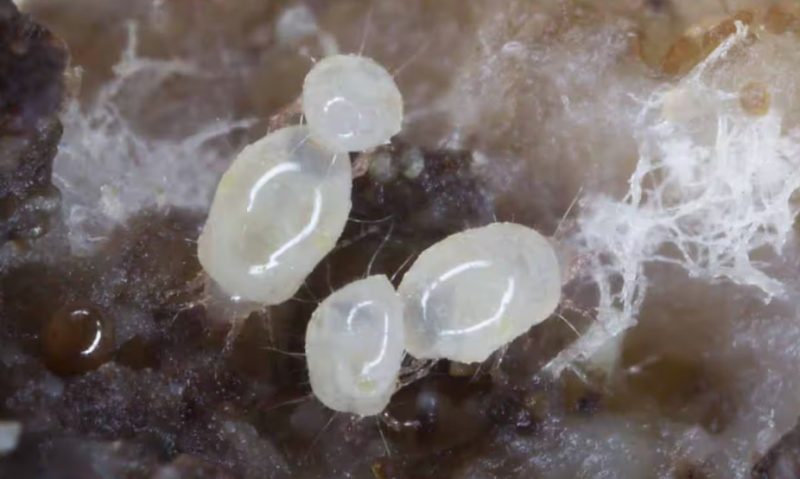
Mold mites are minuscule arachnids measuring less than 0.5 millimeters long, making them nearly invisible without magnification. They have soft, translucent bodies that range from white to pale brown and thrive in damp, moldy environments. In Florida’s humid climate, they are commonly found in bathrooms, basements, kitchens, and food storage areas where moisture and mold growth are abundant.
These mites feed primarily on mold spores and fungi rather than on humans or animals. However, their presence often indicates underlying moisture or mildew problems. They can spread across stored food, furniture, or walls with mold, forming a fine, dust-like layer that moves slightly when disturbed. When infestations grow large, mold mites may trigger allergic reactions or mild skin irritation due to airborne body parts and waste.
Because mold mites rely on moisture, controlling humidity is the key to prevention. Cleaning moldy areas with disinfectants, using dehumidifiers, and improving ventilation can effectively reduce their populations. In Florida, where humidity is persistently high, maintaining a dry environment is essential to keeping these microscopic pests at bay.
Pantry Weevils (Flour Beetles, Rice Weevils, etc.)
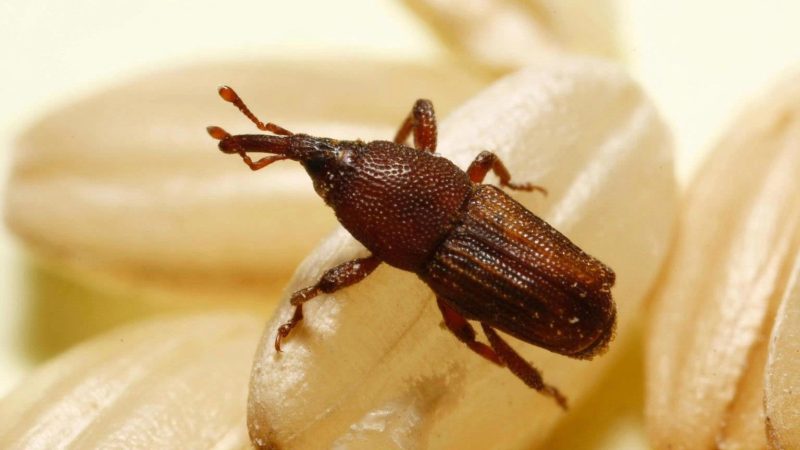
Pantry weevils are small beetles measuring 2 to 4 millimeters long, with elongated bodies and hard shells ranging from reddish-brown to black. Common types in Florida include the rice weevil, granary weevil, and red flour beetle. These insects infest stored grains, flour, cereals, pasta, nuts, and even dry pet food. Once established, they can contaminate large quantities of pantry goods.
Adult weevils chew into food packaging to lay eggs, and the larvae develop inside the grains or dry goods, feeding until they mature. Because Florida’s warm and humid environment accelerates their life cycle, infestations can expand quickly. Weevils are often discovered when tiny holes or powdery residue appear in stored foods.
Pantry weevils do not bite, sting, or transmit diseases, but their presence makes food inedible. Preventing infestations involves inspecting dry goods regularly, storing items in airtight containers, and discarding contaminated foods immediately. Freezing or heating infested items can kill hidden eggs or larvae. In Florida’s climate, frequent pantry checks are essential for keeping these pests under control.
Fungus Gnats
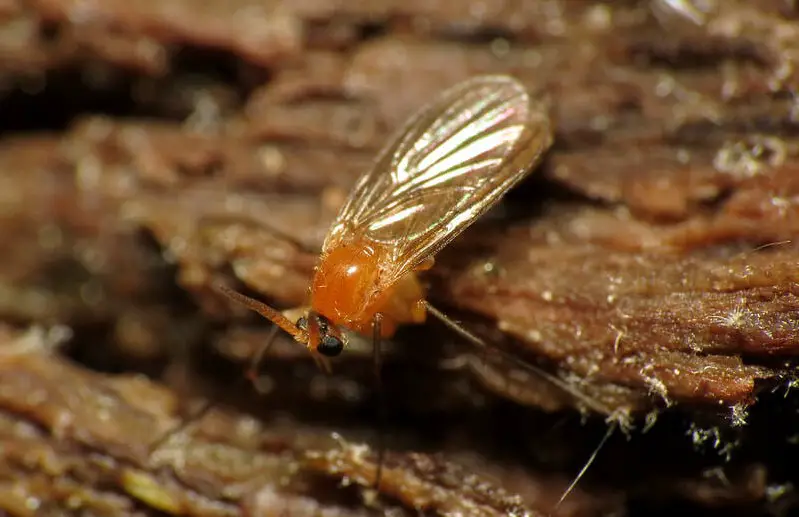
Fungus gnats are small, mosquito-like flies that measure about 2 to 4 millimeters long, with dark bodies, long legs, and transparent wings. They are especially common in Florida’s warm and moist environments, where they thrive in the soil of houseplants, greenhouses, and gardens. Adult gnats are weak fliers and often seen hovering near plant pots or windows.
The larvae, which are slender and translucent with black heads, live in moist soil and feed on fungi, decaying organic matter, and sometimes tender plant roots. Heavy infestations can stunt plant growth or kill seedlings. Adults are mostly a nuisance indoors, while larvae cause the real damage beneath the soil surface. Overwatering plants or using poorly draining soil often leads to infestations.
Fungus gnats do not bite or harm humans, but their presence indicates excessive soil moisture. In Florida, managing them requires allowing soil to dry between waterings, using sticky traps to capture adults, and applying biological controls like Bacillus thuringiensis israelensis (BTI) for larvae. Consistent moisture management is the key to preventing recurrence.
Leaf Miners
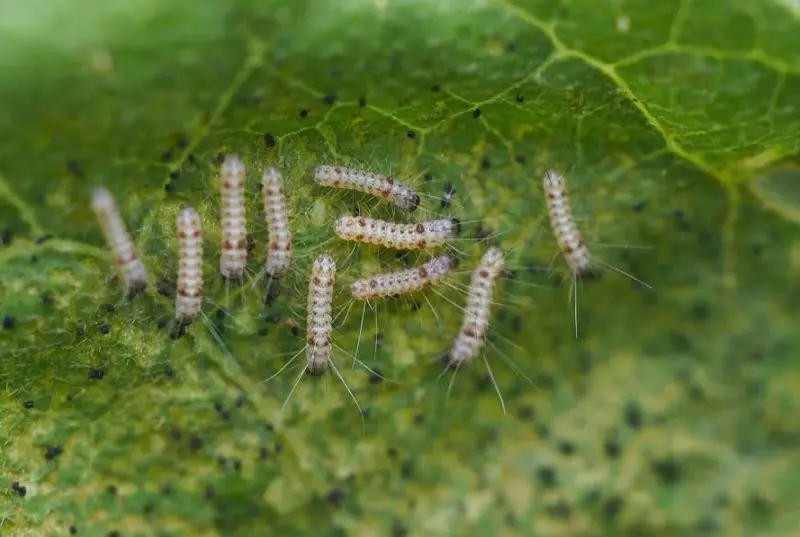
Leaf miners are not a single species but a group of insect larvae—including those of flies, moths, and beetles—that live and feed between the layers of leaves. They are extremely small, typically less than 3 millimeters long, and leave behind distinctive winding trails or blotches on foliage. In Florida’s lush environment, leaf miners are common pests on vegetables, ornamentals, and citrus plants.
The larvae tunnel within leaves, consuming plant tissue while protected from predators and pesticides. As they feed, they create pale, serpentine lines or blotches that can reduce a plant’s ability to photosynthesize. Infested leaves may curl, yellow, and drop prematurely. Adults are rarely noticed—they are tiny flies or moths that emerge to lay eggs on new foliage.
Leaf miners do not pose any threat to humans or animals, but their feeding damage can significantly affect crop yields and ornamental plant health. Controlling them involves removing affected leaves, using sticky traps for adults, and encouraging beneficial insects such as parasitic wasps. In Florida’s warm climate, leaf miner activity peaks during spring and summer, requiring regular garden monitoring.
Tiny Jumping Spiders (Juveniles Often Mistaken for Other Bugs)
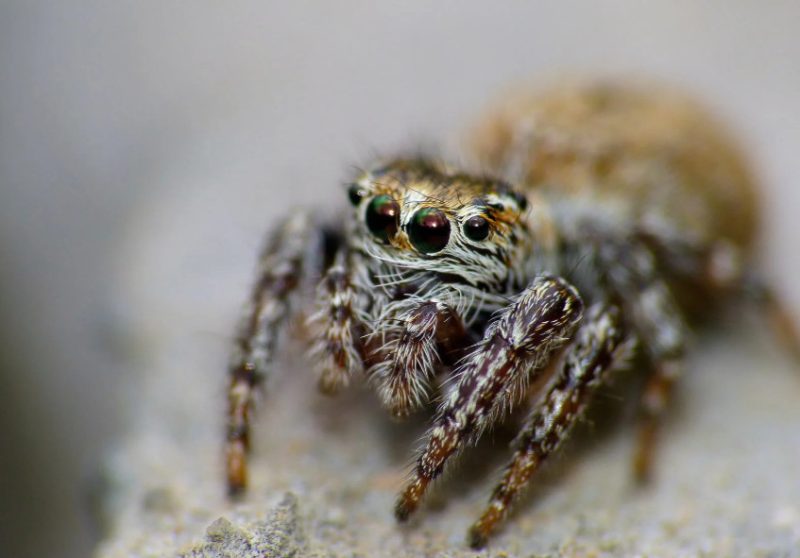
Tiny jumping spiders are small, active arachnids ranging from 1 to 4 millimeters in length when young. Juveniles are often mistaken for ants, ticks, or other tiny insects due to their compact bodies and quick, darting movements. They have large forward-facing eyes that give them excellent vision and a distinctive, alert appearance. In Florida, these spiders are commonly found in gardens, on walls, and even inside homes.
Unlike most spiders, jumping spiders do not spin webs to catch prey. Instead, they actively hunt small insects and other arthropods, leaping several times their body length to capture them. Their movement is sudden but harmless—they rarely bite humans and do so only if handled roughly. Juvenile jumping spiders often exhibit curious behavior, pausing to observe their surroundings before moving again.
These spiders are beneficial predators that help control household and garden pests such as gnats, aphids, and mites. In Florida’s warm, insect-rich environment, they thrive year-round and can be seen during daylight hours. Because they pose no threat to humans, they are best left alone or gently relocated outdoors where they continue their natural pest control role.
FAQs About Tiny Bugs in Florida
What are the most common tiny bugs found in Florida homes?
The most common tiny bugs in Florida homes include ghost ants, sugar ants, booklice, springtails, and fruit flies. These pests are often drawn indoors by humidity, leftover food, or moisture leaks.
Do tiny bugs in Florida bite humans?
Some tiny bugs do bite, such as no-see-ums, sand fleas, and fleas. Others, like booklice or springtails, don’t bite but can cause irritation or discomfort if they appear in large numbers.
Why do I see so many tiny bugs in my Florida bathroom?
Bathrooms in Florida attract bugs like drain flies, springtails, and mold mites because of constant humidity and moisture. Keeping surfaces dry and cleaning drains regularly helps prevent infestations.
Are tiny white bugs in Florida dangerous?
Most tiny white bugs—like mold mites or mealybugs—are harmless to humans but can indicate moisture problems or plant infestations. However, if they’re biting, they might be sand fleas or no-see-ums.
How can I identify tiny biting bugs in Florida?
Tiny biting bugs are often no-see-ums, sand fleas, or fleas. They’re very small (sometimes nearly invisible) and leave itchy red marks after feeding. Using a magnifying glass or sticky traps can help identify them.
What attracts tiny bugs to Florida kitchens?
Food crumbs, overripe fruit, and moisture attract bugs like ants, fruit flies, and pantry weevils. Storing food in sealed containers and cleaning countertops frequently can reduce these pests.
How do I get rid of tiny bugs in Florida naturally?
You can use natural solutions such as vinegar traps for fruit flies, diatomaceous earth for ants, or essential oils like peppermint and tea tree oil to repel insects. Reducing moisture and sealing entry points also helps.
When should I call pest control for tiny bugs in Florida?
If you notice repeated infestations, mysterious bites, or large numbers of bugs even after cleaning, it’s time to contact a professional pest control service. Persistent humidity can make DIY methods less effective.

